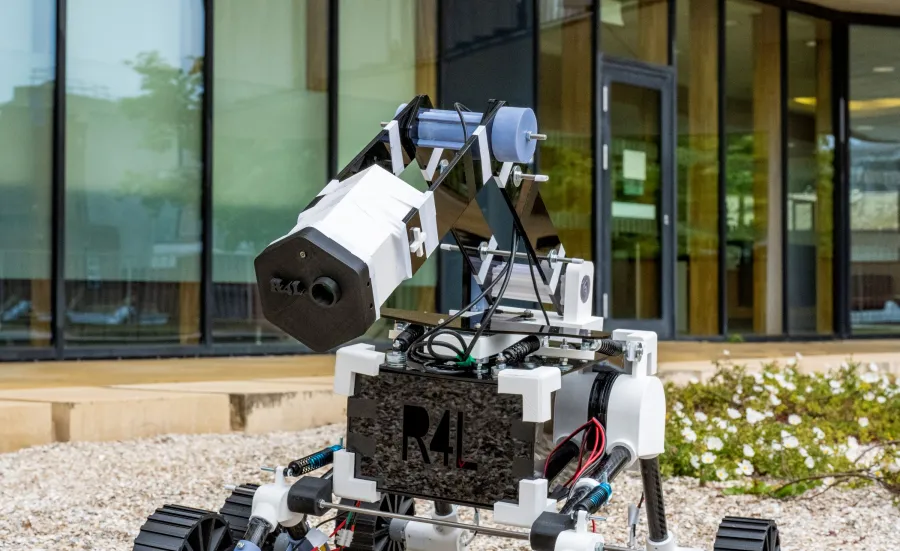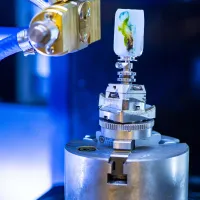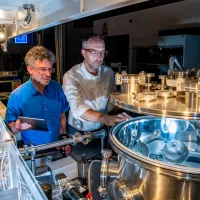Professor of Molecular BioPhotonics and Imaging Sumeet Mahajan, is leading investigations using Raman spectroscopy that uses light-induced vibrations to non-invasively detect and monitor diseases such as cancer or osteoarthritis.
He and PhD students Jake Kleboe and Hiroki Cook built a replica Mars rover to use as an interactive exhibit at shows and exhibitions. It demonstrates how the technology detects possible traces of life on the planet, and how this can work as a transformative tool to diagnose and treat disease.
Looking for molecules in a non-invasive way
NASA’s rover Perseverance is using Raman spectroscopy to look for signs of life on Mars. It is exactly the same technology that is being used to develop disease detection. While NASA is looking for molecules that might have represented life, Sumeet’s research is looking for molecules in living patients to diagnose diseases.
The research explores how Raman spectroscopy and similar label-free light-based techniques can be developed to enable better, earlier and more accurate diagnoses of skin cancer and bone disease. It aims to do this from outside the body using harmless light, without X-ray radiation or chemical labels.
Sumeet and Richard Oreffo, Professor of Musculoskeletal Science at Southampton, are part of InLightenUs: a multimillion-pound interdisciplinary programme funded by the Engineering and Physical Sciences Research Council.
InLightenUs aims to significantly transform diagnostics. Currently, disease diagnosis takes a long time as a biopsy has to be taken and sent for analysis, whereas Raman spectroscopy and other InLightenUs technologies could enable instant diagnosis.
Our ultimate vision for 2050 and beyond is a walk-through arch, similar to an airport scanner. This could instantly scan your body up to a depth of 10cm and provide an immediate diagnosis for a whole range of diseases. Hand scanners could be achieved sooner.
We expect that within five years a combination of the techniques developed by InLightenUs will be able to scan several millimetres beneath the skin to help diagnose diseases.
Professor Sumeet Mahajan
Engaging the public in transformative healthcare science
A key part of the project is sharing the technology and developments with the wider public. The outreach activities are an important way of sharing with a wider audience how innovations in disease detection technology on Earth go hand in hand with amazing discoveries in space.
The replica Mars Rover has been showcased alongside other interactive activities at the Royal Society Summer Science Exhibition, in London, as well as two Southampton Science and Engineering Festivals.
Members of the public had the opportunity to pilot the rover across a simulated Mars surface to discover how it uses light to detect molecules of life on Mars.
Other activities included:
- a range of singing bowls demonstrating how vibrations behave when a mallet is run around the rim
- a rainbow resonator featuring balls that vibrate at different frequencies according to the colour of the light behind them
- ‘Dr Raman’, a semi-automated microscope that can determine which tissues are healthy and which are diseased in ‘biopsies’ taken from mannequin patients
Developing the technology for future impact
The imaging techniques for diagnosis are being further developed with a new Prosperity Partnership between the University of Southampton, global pharmaceutical company AstraZeneca and technology company M Squared Life.
The 5-year partnership, called Transformative Imaging for Quantitative Biology (TIQBio), aims to revolutionise the technology to accelerate drug discovery. They are developing tools to provide live, high-resolution 3D images on a large scale to determine the impact of new drug candidates and their effectiveness in treating various conditions.
It is being led by Sumeet and includes Southampton colleagues from the Institute for Life Sciences, the Optoelectronics Research Centre, Biological Sciences and Medicine.






